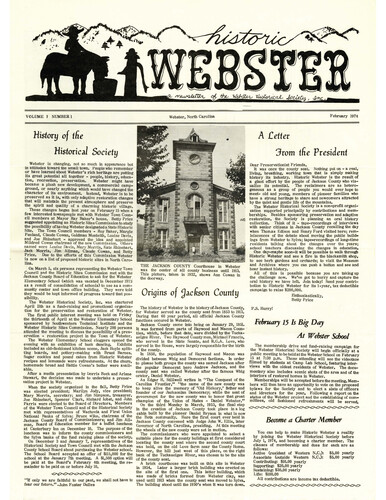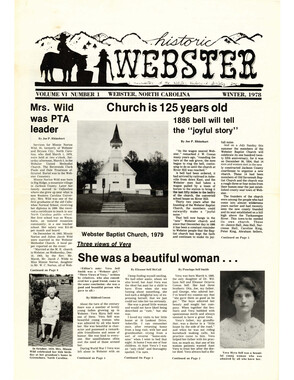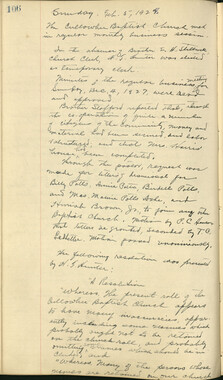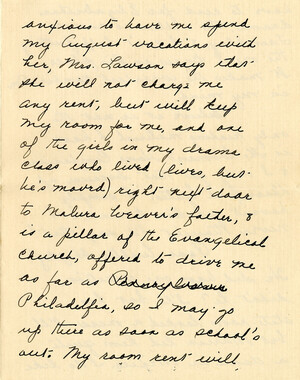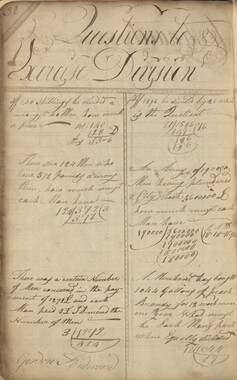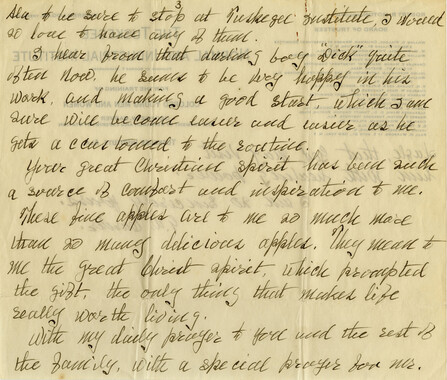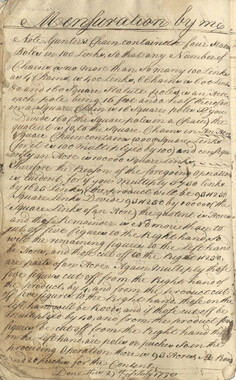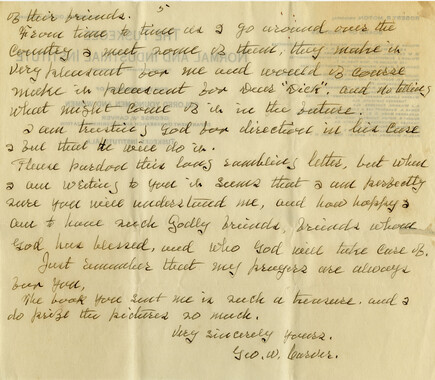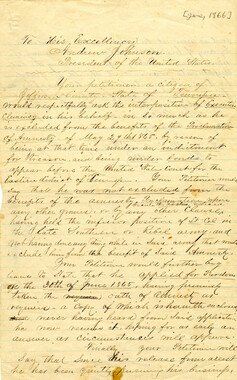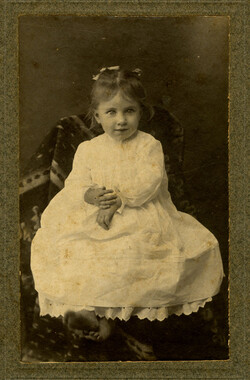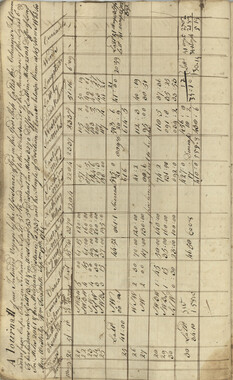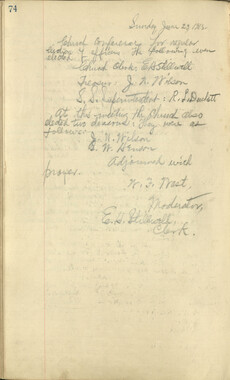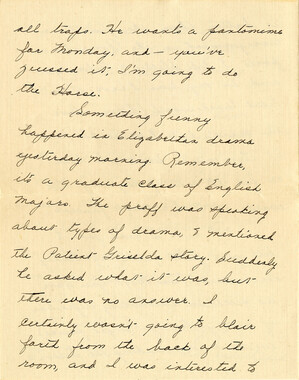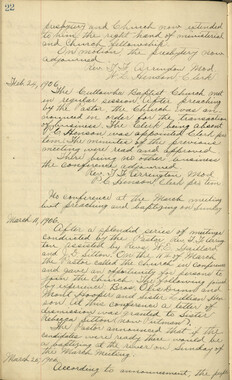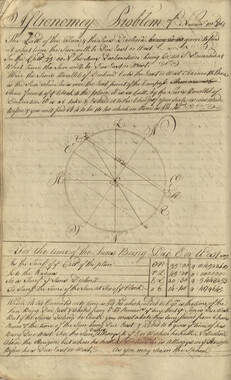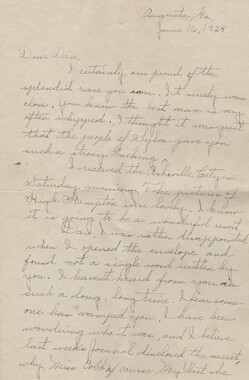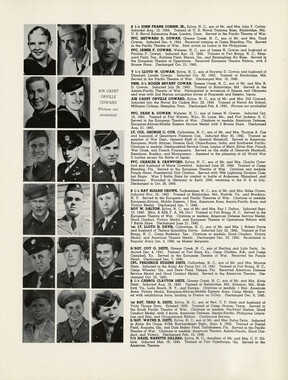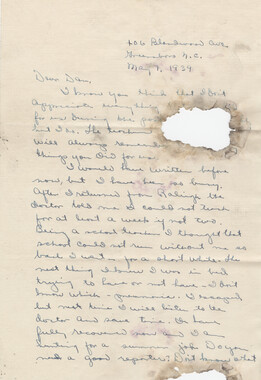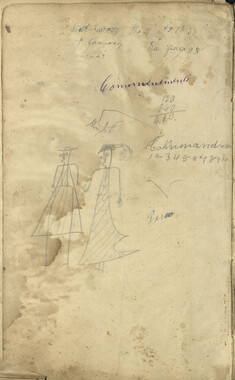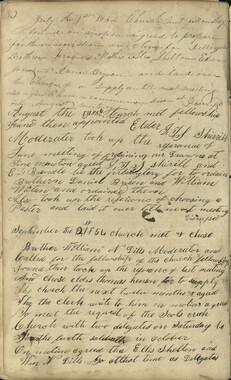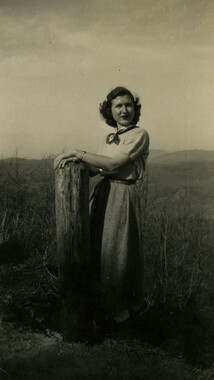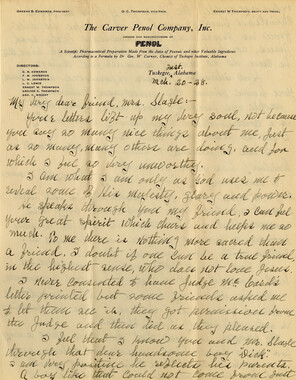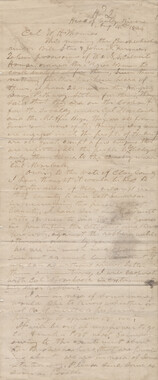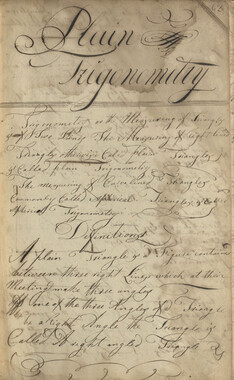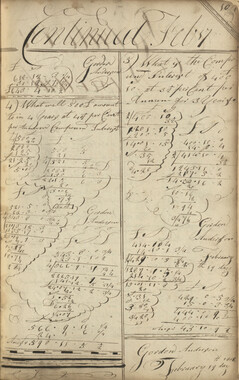Western Carolina University (21)
View all
- Canton Champion Fibre Company (2308)
- Cherokee Traditions (291)
- Civil War in Southern Appalachia (165)
- Craft Revival (1942)
- George Masa Collection (137)
- Great Smoky Mountains - A Park for America (3182)
- Highlights from Western Carolina University (422)
- Horace Kephart (998)
- Journeys Through Jackson (159)
- LGBTQIA+ Archive of Jackson County (90)
- Oral Histories of Western North Carolina (318)
- Picturing Appalachia (6617)
- Stories of Mountain Folk (413)
- Travel Western North Carolina (153)
- Western Carolina University Fine Art Museum Vitreograph Collection (129)
- Western Carolina University Herbarium (92)
- Western Carolina University: Making Memories (738)
- Western Carolina University Publications (2491)
- Western Carolina University Restricted Electronic Theses and Dissertations (146)
- Western North Carolina Regional Maps (71)
- World War II in Southern Appalachia (131)
University of North Carolina Asheville (6)
View all
- Allanstand Cottage Industries (62)
- Appalachian National Park Association (53)
- Bennett, Kelly, 1890-1974 (1463)
- Berry, Walter (76)
- Brasstown Carvers (40)
- Carver, George Washington, 1864?-1943 (26)
- Cathey, Joseph, 1803-1874 (1)
- Champion Fibre Company (233)
- Champion Paper and Fibre Company (297)
- Cherokee Indian Fair Association (16)
- Cherokee Language Program (22)
- Crowe, Amanda (40)
- Edmonston, Thomas Benton, 1842-1907 (7)
- Ensley, A. L. (Abraham Lincoln), 1865-1948 (275)
- Fromer, Irving Rhodes, 1913-1994 (70)
- George Butz (BFS 1907) (46)
- Goodrich, Frances Louisa (120)
- Grant, George Alexander, 1891-1964 (96)
- Heard, Marian Gladys (60)
- Kephart, Calvin, 1883-1969 (15)
- Kephart, Horace, 1862-1931 (313)
- Kephart, Laura, 1862-1954 (91)
- Laney, Gideon Thomas, 1889-1976 (439)
- Masa, George, 1881-1933 (61)
- McElhinney, William Julian, 1896-1953 (44)
- Niggli, Josephina, 1910-1983 (10)
- North Carolina Park Commission (105)
- Osborne, Kezia Stradley (9)
- Owens, Samuel Robert, 1918-1995 (11)
- Penland Weavers and Potters (36)
- Roberts, Vivienne (15)
- Roth, Albert, 1890-1974 (142)
- Schenck, Carl Alwin, 1868-1955 (1)
- Sherrill's Photography Studio (2565)
- Southern Highland Handicraft Guild (127)
- Southern Highlanders, Inc. (71)
- Stalcup, Jesse Bryson (46)
- Stearns, I. K. (213)
- Thompson, James Edward, 1880-1976 (226)
- United States. Indian Arts and Crafts Board (130)
- USFS (683)
- Vance, Zebulon Baird, 1830-1894 (1)
- Weaver, Zebulon, 1872-1948 (58)
- Western Carolina College (230)
- Western Carolina Teachers College (282)
- Western Carolina University (2008)
- Western Carolina University. Mountain Heritage Center (18)
- Whitman, Walt, 1819-1892 (10)
- Wilburn, Hiram Coleman, 1880-1967 (73)
- Williams, Isadora (3)
- Cain, Doreyl Ammons (0)
- Crittenden, Lorraine (0)
- Rhodes, Judy (0)
- Smith, Edward Clark (0)
- Appalachian Region, Southern (3032)
- Asheville (N.C.) (1945)
- Avery County (N.C.) (26)
- Blount County (Tenn.) (200)
- Buncombe County (N.C.) (1680)
- Cherokee County (N.C.) (283)
- Clay County (N.C.) (556)
- Graham County (N.C.) (247)
- Great Smoky Mountains National Park (N.C. and Tenn.) (535)
- Haywood County (N.C.) (3573)
- Henderson County (N.C.) (70)
- Jackson County (N.C.) (4926)
- Knox County (Tenn.) (61)
- Knoxville (Tenn.) (21)
- Lake Santeetlah (N.C.) (14)
- Macon County (N.C.) (421)
- Madison County (N.C.) (216)
- McDowell County (N.C.) (39)
- Mitchell County (N.C.) (135)
- Polk County (N.C.) (35)
- Qualla Boundary (982)
- Rutherford County (N.C.) (78)
- Swain County (N.C.) (2187)
- Transylvania County (N.C.) (270)
- Watauga County (N.C.) (12)
- Waynesville (N.C.) (86)
- Yancey County (N.C.) (72)
- Aerial Photographs (3)
- Aerial Views (60)
- Albums (books) (4)
- Articles (1)
- Artifacts (object Genre) (228)
- Bibliographies (1)
- Biography (general Genre) (2)
- Cards (information Artifacts) (38)
- Clippings (information Artifacts) (193)
- Copybooks (instructional Materials) (3)
- Crafts (art Genres) (622)
- Depictions (visual Works) (21)
- Design Drawings (1)
- Digital Moving Image Formats (2)
- Drawings (visual Works) (185)
- Envelopes (115)
- Exhibitions (events) (1)
- Facsimiles (reproductions) (1)
- Fiction (general Genre) (4)
- Financial Records (12)
- Fliers (printed Matter) (67)
- Glass Plate Negatives (381)
- Guidebooks (2)
- Internegatives (10)
- Interviews (823)
- Land Surveys (102)
- Letters (correspondence) (1070)
- Manuscripts (documents) (618)
- Maps (documents) (177)
- Memorandums (25)
- Minutes (administrative Records) (59)
- Negatives (photographs) (6192)
- Newsletters (1290)
- Newspapers (2)
- Notebooks (8)
- Occupation Currency (1)
- Paintings (visual Works) (1)
- Pen And Ink Drawings (1)
- Periodicals (194)
- Personal Narratives (10)
- Photographs (12977)
- Plans (maps) (1)
- Poetry (6)
- Portraits (4573)
- Postcards (329)
- Programs (documents) (181)
- Publications (documents) (2444)
- Questionnaires (65)
- Relief Prints (26)
- Sayings (literary Genre) (1)
- Scrapbooks (282)
- Sheet Music (2)
- Slides (photographs) (402)
- Songs (musical Compositions) (2)
- Sound Recordings (802)
- Specimens (92)
- Speeches (documents) (18)
- Tintypes (photographs) (8)
- Transcripts (329)
- Text Messages (0)
- A.L. Ensley Collection (275)
- Appalachian Industrial School Records (7)
- Appalachian National Park Association Records (336)
- Axley-Meroney Collection (2)
- Bayard Wootten Photograph Collection (20)
- Bethel Rural Community Organization Collection (7)
- Blumer Collection (5)
- C.W. Slagle Collection (20)
- Canton Area Historical Museum (2110)
- Carlos C. Campbell Collection (564)
- Cataloochee History Project (64)
- Cherokee Studies Collection (4)
- Daisy Dame Photograph Album (5)
- Daniel Boone VI Collection (1)
- Doris Ulmann Photograph Collection (112)
- Elizabeth H. Lasley Collection (1)
- Elizabeth Woolworth Szold Fleharty Collection (4)
- Frank Fry Collection (95)
- George Masa Collection (173)
- Gideon Laney Collection (452)
- Hazel Scarborough Collection (2)
- Hiram C. Wilburn Papers (28)
- Historic Photographs Collection (236)
- Horace Kephart Collection (861)
- Humbard Collection (33)
- Hunter and Weaver Families Collection (1)
- I. D. Blumenthal Collection (4)
- Isadora Williams Collection (4)
- Jesse Bryson Stalcup Collection (47)
- Jim Thompson Collection (224)
- John B. Battle Collection (7)
- John C. Campbell Folk School Records (80)
- John Parris Collection (6)
- Judaculla Rock project (2)
- Kelly Bennett Collection (1482)
- Love Family Papers (11)
- Major Wiley Parris Civil War Letters (3)
- Map Collection (12)
- McFee-Misemer Civil War Letters (34)
- Mountain Heritage Center Collection (4)
- Norburn - Robertson - Thomson Families Collection (44)
- Pauline Hood Collection (7)
- Pre-Guild Collection (2)
- Qualla Arts and Crafts Mutual Collection (12)
- R.A. Romanes Collection (681)
- Rosser H. Taylor Collection (1)
- Samuel Robert Owens Collection (94)
- Sara Madison Collection (144)
- Sherrill Studio Photo Collection (2558)
- Smoky Mountains Hiking Club Collection (616)
- Stories of Mountain Folk - Radio Programs (374)
- The Reporter, Western Carolina University (510)
- Venoy and Elizabeth Reed Collection (16)
- WCU Gender and Sexuality Oral History Project (36)
- WCU Mountain Heritage Center Oral Histories (25)
- WCU Oral History Collection - Mountain People, Mountain Lives (71)
- WCU Students Newspapers Collection (1923)
- Western North Carolina Tomorrow Black Oral History Project (69)
- William Williams Stringfield Collection (2)
- Zebulon Weaver Collection (109)
- African Americans (390)
- Appalachian Trail (35)
- Artisans (521)
- Cherokee art (84)
- Cherokee artists -- North Carolina (10)
- Cherokee language (21)
- Cherokee pottery (101)
- Cherokee women (208)
- Church buildings (190)
- Civilian Conservation Corps (U.S.) (114)
- College student newspapers and periodicals (2012)
- Dams (115)
- Dance (1023)
- Education (222)
- Floods (63)
- Folk music (1015)
- Forced removal, 1813-1903 (2)
- Forest conservation (220)
- Forests and forestry (1198)
- Gender nonconformity (4)
- Great Smoky Mountains National Park (N.C. and Tenn.) (181)
- Hunting (47)
- Landscape photography (25)
- Logging (122)
- Maps (83)
- Mines and mineral resources (9)
- North Carolina -- Maps (18)
- Paper industry (38)
- Postcards (255)
- Pottery (135)
- Railroad trains (72)
- Rural electrification -- North Carolina, Western (3)
- School integration -- Southern States (2)
- Segregation -- North Carolina, Western (5)
- Slavery (5)
- Sports (452)
- Storytelling (243)
- Waterfalls -- Great Smoky Mountains (N.C. and Tenn.) (66)
- Weaving -- Appalachian Region, Southern (280)
- Wood-carving -- Appalachian Region, Southern (328)
- World War, 1939-1945 (174)
Historic Webster Vol. 1 No. 1
-
Historic Webster is a newsletter of the Webster Historical Society, Inc., created at the Society’s founding in 1974. The publication helped to serve the Society's mission of collecting and preserving the history of Webster, North Carolina. Webster, established in 1851, was the original county seat for Jackson County.
-
-
VOLUME I· NUMBER I History of t6e Historical Society Webster is changing, not so much in appearance but in attitudes toward toe small town. People who remember or have learned about Webster's rich heritage are putting its great potential all together - people, history, education, recreation, preservation. Webster might have became a plush new development, a commercial campground, or nearly anything which would have changed the character of its environment. Instead, Webster is to be preserved as it is, with only adaptive restoration changes that will maintain the present atmosphere and preserve the spirit and quality of a charming historic village. These changes began last year on February 15 when a few interested townspeople met with Webster Town Coun. cil members at Mayor Ray Baker's house. Betty Price suggested appointing an Historic Sites Commission to study the possibility of having Webster designated a State Historic Site. The Town Council members - Roy Baker, Margie Penland, Claude Cowan, Goldman Monteith, Louise Davis, and Joe Rhinehart - approved the idea and appointed Mildred Cowan chairman of the new Commission. Others named were Louise Davis, Mary Morris, Kate Rhinehart, Jack Morris, Jim Allman, Claude Cowan, and Betty Price. Due to the efforts of this Commission Webster is now on a list of proposed historic sites in North Carolina. On March 5, six persons representing the Webster Town Council and the Historic Sites Commission met with the Jackson County Board of Education to ask for the Webster Elementary School (which was vacated in December 1973' as a result of consolidation of schools) to use as a community center and town office building. They were told they would be kept informed of progress toward that possibility. The Webster Historical Society, Inc. was chartered April lith as a fund-raising and promotional organization for the preservation and restoration of Webster. The first public interest meeting was held on Friday· the thirteenth of April at the Webster Elementary School sponsored by Southwestern Technical Institute and the Webster Historic Sites Commission. Nearly 200 persons attended the meeting to discuss the possibility of a preservation - restoration project in the Town of Webster. The Webster Elementary School cloggers opened the evening with an exhibition of buck dancing. Exhibits included an old-fashioned kitchen scene, Jack Hoyle splitting boards, and pottery-making with Brant Barnes. Sugar cookies and pound cakes from Historic Webster recipes and lemonade were refreshments. At the churn, homemade bread and Hattie Cowan's butter were available. After a media presentation by Dorris Beck and Arlene Stewart, the decision was made to undertake a preservation project in Webster. When the society organized in the tall, Betty Price was elected president; Marilyn Jody, vice president; Mary Morris, secretary; and Jim Simpson, treasurer. Joe Rhinehart, Spencer Clark, !tichard Iobst, and John Parris were elected to the Board of Directors. Members of the Webster Town Council and of the Historical Society met with representatives of Wachovia and First Union National Banks of Sylva: Bruce Wike; chairman of the Jackson County Board of Commissioners; and Jim Allman ·, Board of Education member for a buffet luncheon at Canterbury Inn on December 10. The purpose of the luncheon was to inform the county commissioners and the Sylva banks of the fund raising plans of the society. On December 3 and January 7, representatives of the Historical Society and Town Council met with the Jackson County School Board about purchasing the Webster school. The School Board accepted an offer of $ll5,000 for the school at the January 7th meeting. A $1,500 option will be paid at the Board's February 4th meeting, the remainder to be paid on or before July 10. ~ "If only we are faithful to our past, we shall not have to fear our future." -John Foster Dulles Webster, North Carolina THE JACKSON COUNTY Courthouse in Webster was the center of all county business until 1913. This picture, taken in 1932, shows Ann Cowan in the doorway. Origins of ~ackson County The history of Webster is the history of Jackson County, for Webster served as the county seat from 1853 to 1913. During that 60 year period, all official Jackson County functions occured in Webster. Jackson County came into being on January 29, 1851. It was formed from parts of Haywood and Macon Counties, which, before that date, were divided by the Tuckaseigee River. Two Haywood County men, Michael Francis, who served in the State Senate, and R.G.A. Love, who served in the House, were largely responsible for the birth of the county. In 1850, the population of Haywood and Macon was divided between Whig and Democrat factions. In order to please both groups the county was named Jackson after the popular Democrat . hero Andrew Jackson, and the county seat was called Webster after the famous Whig orator, Daniel Webster. As Edgar H. Stillwell writes in "The Conquest of the Carolina Frontier ,t' "the name of the new county was to keep alive the memory of 'Old Hickory,' father and founder of our Jacksonian Democracy; while the seat of government for the new county was to honor that great champion- of the Union of States - Daniel Webster." On the third Monday in March, 1953, the final step in the creation of Jackson County took place in a log cabin built by the piontier Daniel Bryson in what is now the Beta community. Here the first court ever held in Jackson County convened with Judge John W. Ellis, later Governor of North Carolina, presiding. At this meeting the wheels of the new county were set in motion. The commissioners who were appointed to select a suitable place for the county buildings at first considered locating the county seat where the second county court was held, on the old Love farm near the County Home. However, the hill just west of this place, on the right bank of the Tuckaseigee River, was chosen to be the site of the county seat. A brick courthouse was built on this site in Webster in 1854. Later a larger brick building was erected on the site of the first one. This latter building, which was made of bricks formed from Webster clay, wa" used until 1913 when the county seat was moved to Sylva. The building stood until the 1930's when it was torn down. February 197 4 A fetter 3rom t6e President Dear Preservationist Friends, It was once the county seat. Nothing put on - a real, living, breathing, working town that is simply making history its industry. Historic Webster is the result of a giant effort by the people of Jackson County who visualize its ootential. The reclaimers are as heterogeneous as a group of people you would ever hope to meet- old and young, members of pioneer families who have a strong heritage to share and newcomers attracted by the quiet and gentle life of t~?e m?untains. . . The Webster Historical SoCiety IS a non-prof1t orgamzation supported principally by contributions and memberships. Besides sponsoring preservation and adaptive restoration, the Society is planning an oral history collection. Think of it - tape-recordings of interviews with senior citizens in Jackson County recalling the day when Thon.as Edison and Henry Ford ·visited here; reminiscences of the debate about moving the public buildings from Webster to Sylva; tape-recordings of long-time residents talking about the changes over the years; school teachers discussing the changes in education. One day-maybe soon-it will be possible to walk through Historic Webster and see a fire in the blacksmith shop, to see herb gardens and orchards; to visit the Museum and Archives where you can push a button and see and hear instant history. All of this is possible because you are taking up the challenge now. We've got to hurry and capture the oral history we have left. Join today! Send your contribution to Historic Webster for its 1-year, tax deductible campaign to raise $200,000. P.S. Hurry! Ehthusiastically, Betty Price February 15 Is Big Day At Webster School The membership drive and fund-raising campaign for the Webster Historical Society will begin officially at a public meeting to be held at the Webster School on February 15 at 7:30 p.m. Those attending will see the videotaoe filmed by students at Camp Lab School, featuring inter· vi_ews with the oldest residents of Webster, The documentary also includes scenic shots of the area and of the interiors of restored homes in Webster. . ·Me.mberships will be accepted before the meeting. Members will then have an opportunity to vote on the proposed bylaws for the Society and to elect a slate of officers and idrectors for the year. Following a report on the status of the Webster project and the establishing of committees, old fashioned refreshments will be served. Become a Charter Member You can help to make Historic Webster a reality by joining the Webster Historical Society before July I, 1974, and becoming a charter member, The classes of membership and dues for each are as follows: Active (resident of Western N.C.): $5.00 yearly Associate (outside Western N.C.): $5.00 yearly Contributing: $10.00 yearly Supporting: $20.00 yearly Sustaining: $30.00 yearly Life: $100.00 All contributions are income tax deductible. Page 2 HISTORIC WEBSTER February 1974 A Guide To The Map Of Webster This drawing of Webster at the turn of the century has been compiled by Betty Price, Through records, ne·wspaper articles, and with the help of Claude Cowan, Lily (Nanniehart) Rhinehart, Arthur Allman and Mildred Cowarr,-the-JI'ap-has beefnlrawn up to simula:te Webster around 1900. The town well across from the Court House is the one depicted in the HISTORIC WEBSTER banner. The well, according to Nanniehart, was a gathering place for thirsty travelers and their horses. Though the well has been filled in, its cornerstones can still be seen next to the Webster Post Office. · '!be Court House was built with red bricks from the clay mine and brick plant across the river. The Webster clay mine also supplied clay for dolls' heads and fine china made in New Jersey, The Wilde store, the two mills, and the homes on the river were washed away in the flood of 1940, and the road was rebuilt closer to the river, on the site of these buildings. Prize Given For Design The Historic Webster bannerhead was designed and drawn by Karen Moscowitz, a sophomore art student at Western Carolina University, Prof. Ray Menze's two-dimensional drawing classes took the newsletter bannerhead as a class project, and the work of each student was submitted to the Historical Society for review, Members of the Historical Society Executive Committee chose Moscowitz's work out of approximately 30 entries. Moscowitz, who comes from Leona, New Jersey, will be awarded five dollars by the Historical Society for her efforts, The Mountain View Hotel, ~athan Coward Hotel, drug store, Tuckaseigee Bank, and Allison home were destroyed in the fire of 1910. The Allison home has since been rebuilt in its original style, The map was drawn by Julie Blankenship, a student at Southwestern Technical Institute. If you have any additions or corrections to the map, or if you can narrow down the date to a more specific year, please write Betty Price, Drawer w, Webster, N.C. 28788. Any information about specific homes or buildings will be welcomed. In "Jackson County: Its Climate :and Natural Resources," a column in THE TUCKASEIGE DEMOCRAT, this siatement appeared each week: ... "The water is pure, cool and sweet, and for household purposes is taken from springs with which the county abounds." olie 'Oown of We6ster around 1900 OJokbook <.oll'hw..., (_()\l)o."\ L...woH:
Will Provide - Good Reading A forthcoming Webster recipe book promises to provide not only a cpllection of Webster's oldest and most delicious dishes but also interesting reading and browsing material. The cookbook, which is currently being compiled by Flossie and Joe Parker Rhinehart, will feature original pen and ink drawings of people and places in Webster. Character sketches of the donating cooks will accompany some of the mouth-watering recipes, and Joe Parker is compiling a series of "Growing Up In Webster" stories written by Webster women of several generations. Mildred Cowan, Mary Morris and other women who grew up in Webster have been asked to contribute their accounts. The recipes in the book were collected from cooks in the area by Joe's mother, Kate Rhinehart. Flossie Rhinehart will draw the pen and ink sketches. The Rhineharts hope to have the cookbook completed and on sale by mid-April. The recipe book is a fund raising project of the Webster Historical Society, Inc, Joe Parker Rhinehart, who grew up in Webster, and his wife Flossie, who comes from Georgetown, Kentucky, now live and teach school in Bethesda, Maryland, They have worked with the historic preservation and restoration of Murfreesboro, N.C., where they are restoring a home, HISTORIC WEBSTER February 1974 Page 3 Nanniehart Recounts Her Memories Of Webster NANNIEHART in her earlier years. This photograph was taken when she was about eighteen or twenty years old. Arthur Allman Nanniehart was born Lily Cagle on August. 13, 1881. She and her husband, J. W. Rhinehart, used to run the Mountam View Hotel until it burned down in 1910. After that, the Rhineharts managed hotels in Sylva and Bryson City before they came home to Webster and opened up the country store across from the Court House. Nanniehart got her nickname 34 years ago when her grandson, Joe Parker Rhinehart, was a baby whose ver sion of " Granny Rhinehart, came out "Nanniehart/' Now there's not a person in Webster who calls her anything else. As the oldest resident of Webster, Nanniehart tells some colorful stories of the town in its younger days. Of her school days, she says, "I was raised out on a farm about two miles from here, When I first went to school I didn't come in to town. I went to a country school. That was four months' school. Later on they changed us to the Baptist Church at the top of the river hill, we'd go .ill_ven monthLout of the year. in the summer, thy'd have what they subscription school and I went to that. That was when a teacher would come wantin' to work in the summer and he'd char ge either 50¢ a week or 50¢amonth,Ican't remember . But I went to school every chance I could get up until I was 18. I would have kept on then but my mother go~ sick and I had to stay home." Is Prize Storyteller Arthur Allman has a story to tell about practically every person or event he can remember throughout his 89 years in Webster. And he's even got some tales about times he can't remember - like being born on March 17, 1884. His parents, Polk and Betty Allman lived on the George Penland place at that time. Dr. Candler was the doctor then, and he was going to come deliver the baby, but, as Arthur relates. "there come the awfullest snow storm you ever saw. We had a picket fence then, and the snow was banked up all around it. I was born, my mother said, at 5:00 in the morning, and of course nobody could get there so the girl that was staying with us and my father were the only ones there when I was borno "Now old llln Boone (no kin to lllniel Boone) lived up in the house right above us, When they shoveled out a trail, his mother came lookin' around, and she saw me and said, 'why, this baby's about froze to death. ' Now her son llln wasn't much older than I was, so she took me home and nursed both of us until my mother could take care of me. And it took three weeks for my mother to get strong enough to take me home. "So, I had it rough from the time I come into the world; I've had it rough and I'm still having it rough." Arthur describes Webster during his childhood as ''a nice clean country town with lots of nice people. The (Tuckaseigee) River was a beautiful river then, clear as a crystal, just as pure as any spring water you could find. You could drink out of it then, and now it's not even clean enough to take a bath in. It was bigger in those days, about four times as big as it is now. And fish--that river was just loaded with fish." The covered bridge in Webster was a gather ing spot during rainstorms until sometime in the nineteen-teens when it was torn down. It, too, sparks a story by Arthur. "That old bridge was covered and had two windows on either side. It sheltered many a person on a rainy day. Hunters would go there to kill ducks. Back then there were no lakes on the river, so there were lots of ducks. Well, one bad rainy day when Bill Henson was sheriff, old Henry Norman and I wer e going to go hun tin ' and we were standing under there because of the rain. Henry had a new double-barrel gun and he was mighty proud of that gun. Now they were strict about taxes then; it's not like it is now; if you didn't pay your taxes they'd just come and take something you owned until you did pay. "Now the sheriff walked in and saw Henry there with that gun, and asked him, 'Henry, is that a good gun?' Of course, Henry was proud of it and told him it was, and the sheriff said, 'well, Henry,Inoticeyouhaven't paid your taxes, so I'll just take the gun until you pay it. • Poor Henry had to give him the gun, and he didn't get to go huntin' that day," ~oin tfie Historical Society 'Godayl . "e The mailing list has been compiled from the Webster township tax listings, the Sylva Herald out-of-county subscription list, a list of Jackson County public school teachers, the Western North Carolina Historical Society membership list, WCU faculty and staff directory; the Appalachian Consortium Board of Directors list and personal lists from members of the Webster Historical Society. 0 D I want to be a Charter Member ~ If you know of anyone who would like to receive the newsletter , please send the name and address to Drawer W, Webster, North Carolina, 28788·. The first three issues of HISTORIC WEBSTER will be sent free to anyone interested in receiving them. Further issues of the newsletter will be sent to all members of the Webster Historical Society at no cost other than membership dues. D My dues are enclosed $5 $10 $20 $30 $100 Active or Associate Contributing Supporti.ng Su stain ing Life I am sending a donation Amount .c "" Nanniehart and her husband Joe were working at the hotel the night of the big fire in 1910, when an entire block of Webster was destroyed. Here is her account of the fire: "I was in the hotel that night. Joe was late coming in from Sy! va and everybody had had supper except him. I gave Joe his supper and went to put the baby to sleep, when I heard !! noise back in the pantry. I said 'Joe,' I said, 'something's wrong back there. There's somebody stealing. • That's what I thought. He went back there and hollered fire. He went on out. We all went running out, and Mr. Gribble, who was there to get some medicine for his wife, he said to me, 'The baby!' I said, 'Yes the baby, I'll go back.' I was crazy, I didn't have any sense. I went back to get the baby and I couldn't find anything to wrap him up in. I could have used a comforter or something, but I didn't think of that then. I got my coat. It was cold, the wind a blowing. I went outside· through- the dining room and ran across the street to the bank. People were throwing things out of the rooms upstairs out at Mrso Cowarct•s boarding houseo We went on down the street. Miss Allison's house was on fire, and she came on out and said, 'Mrs. Rhinehart, don't come to me. Keep on going and take your baby somewhere else. • So I kept on going until I saw the preacher's wife. She told me to come on over to her house and wait till the fire was out. And it was 3:00 in the morning before they got it out. That fire burned up our hotel, the drugstore, the bank, Mr. Andy Allison's house and Mrs. Cowar d's Boarding Houseo" Nanniehart remembers the firstautomobile that came through Webster. "It belonged to the electric light maker, Mr. Thomas Edison. He came to Webster looking for a mineral, cobalt. He drove right up to the soter where I was working. Ever ybody crowded around the car looking at it. He didn't stay long; he just picked up Mr. Lee Wildes and they went out lookin' for cobalt. That was the first car I ever saw. "The next one I r emember was Little Doc Nichols'. He was a doctor in Sylva, and he'd drive through town and blow that horn, and everybody would get excited and run outside and wave, The road was so bad though that cars couldn't always get here. One stretch of the road between here and Sy! va used to get knee deep in mud sometimes, and it'd take four horses to pull a buggy through it." ARTHUR ALLMAN talks with Betty Price about growing up in Webster, Page 4 HISTORIC WEBSTER February 1974 The Empty Webster School Will Soon Become Busy Center The Webster Historical Society has big plans for the as a voting place and community center for recreational Webster SchQql, a 36 year . old stone building re~ently activities for all ages, vacated as a result of consolidation of several elementary The school, which includes aooroximately 9 acres of schools in the Jackson County School System, land, has been promised to the Town of Webster for $ll5,000 Plans call for the building to house the Webster Town payable on or before July 10. The Jackson County Board Council offices, Historical Society Offices, a museum and of Education on January 9 agreed to accept the offer made archives, a restaurant, a community theater, and to serve by the Town Council and Historical Society, with a $1,500 Donate Or Lend To Archives Collection The Webster Historical Society is looking for old manuscripts and books pertinenttothehistoryof Webster, Jackson County or Western North Carolina. Working toward an eventual goal of having an archives in Webster, the historical society has made arrangements to house its collection at the Western Carolina University Archives until archival facilities are developed in the Town of Webster. Items which are being sought include correspondences (family or general), diaries, bills and receipts, account books, hotel registers, books relating to history, legal papers such as wills and deeds, journals, newspapers, maps and photographs. WCIJ Archivist Richard Jobst and his assistant Heni Ca~o?. wil! repair and preserve the materials using deactdiftcatwn treatments for manuscripts and binding whole books if necessary, following procedures accepted by the Society of American Archivists, The items will then be filed in acid free folders by date and category under the name of the doner or lender. The university archives, Ioc.ated on the ground floor of Hunter Library, is fireproof and air conditioned to a constant temperature and humidity level, The building contains a well-lit reading room for research. Cur!iently, the WCU archives houses 55 manuscript collecti()ns and 30 book collections, or a total ofl25.,000 items. Museum items are also welcomed for donation or loan to the Webster Historical Society, Small items will be displayed in the exhibit cases of the WCU Archives, while large itmes will be housed in the Webster School. The Historical Society plans to use several rooms of the school as a public museum. Books, manuscripts, photographs and museum items may be donated or lent to the society by contacting Betty Price, president, or Richard Jobst, University archivist. Gifts are tax deductible, Materials on loan will be re-· turned on request on a thirty-day notice, Museum Donations option to be paid to the Board at its February 4th meeting. Though the school will be sold to the Webster Town Council, the Historical Society is in charge of fund raising and will assume payment obligations and maintenance responsibilities. Four days after the offer was accepted by the school board, the Historical Society had raised more than enough to covet: ·the option payment. Betty · Prfce, President of the Historical Society, is confident that through memberships, contributions, and grants, the society will be able to raise the remaining $ll3,500 by July 10, The school building contains approximately 10 classrooms,_ a lunchroom and kitchen, a gymnatorium (combination gymnasium and auditorium) restrooms and two large storage areas. Outside are paved basketball courts and a large playing field surrounded by white pines, Behind the school is the old school bell, given to the former Webster School by Mrs. W. W. Watts, Care of the World War II memorial in front of the school will be assumed by the Historical Society, A historical play abut Jackson County is currently being written for production by the Webster theater, Several persons have expressed interest in helping to establish the restaurant. Other plans for the building in• clude leasing office space to interested businesses or individuals. WHS Efl(()urages Young Hisknians' Projects The Webster Historical Society plans to sponsor a series of projects in local history for students of all ages, The Society will encourage individual and class projects involving the history of Jackson County. Possibilities include art work, photography, historical research, composition, oral history, or other creative work that is concerned with the history of this area. Tentative plans are being made for publishing a journal of prize-winning projects and for diplaying creative work in the Webster School, It is hoped that individual awards can be presented at an a wards night sometime in late May, A video tape documentary on Webster, now being developed by television classes at Camp laboratory School, wil will be available for showing to interested classes after February 15. A slide-tape narrative will also be shown on request beginning in April. Both of these programs are designed to stimulate interest in local history and to demonstrate what sort of work young historians might undertake, Teachers who are interested in sponsoring a Young Mrs. Karen Gram Allen (formerly Mrs. J. F. Scott Historians project should call or write to Marilyn Jody, of Scott's Hill of Dillsboro), whose log home, guest English Department, Western Carolina University, DeadProject Gets Consortium Grant The Appalachian Consortium has awarded a grant to the Webster Project, a plan initiated by Western Carolina University to help with the preservation and restoration of Webster. The $2,466 Consortium grant will be combined with ti)e University's in-kind contribution of $11,734 to sup]:) Orl a series of three_ _l !lr ojects-a photographic essay, the HISTORIC WEBSTER newsletter, and an archives coliEic.tlon - d~-s-ig;,ed . to promote public interest in the project, according to Dr. l\fl!.rilyn Jody, associate professor of English and project director, Webster, once the county seat of Jackson County, is an unspoiled scenic residential area five miles from the university. The home of the late Robert Lee Madison, founder of Western Carolina, is located there. The photographic essay will consist of a slide narrative to be directed by Mack Sarvis, a graduate student at WCU, and audiovisual teacher at Camp laboratory School in Cullowhee, His students will also undertake as a class project a videotape program which will include scenes of restored homes in Webster and interviews with some of the town's eldest residents, Arthur Allman, Mrs. Joe ''Nanniehart" Rhinehart, Miss Lucy Morgan, founder of the Penland School of Crafts, and others. The Historic Webster slide show will be an oral history approach to the history of Webster; that is, it will be narrated entirely by the voices of those who recall its history. Those involved in the high school television productinn on Webster include Barbie Arney, lliwn !Alvis, larry Arney, Manda Litchford, Kathy Peterson, llin Foxworth, Meg Stuart, Robert Brown, · Jef Wilson, Donna Kiser and Stephanie Robinson. The slide show and the video-tape documentary will be available for showings to clubs and schools in April. Those wishing to borrow either of these programs should write Dr. Marilyn Jody, Drawer W, Webster, N.C. Dr. Richard Jobst, UniversityArchivist,andhisassistant, Heni Cason, will collect and preserve books, documents, and letters relevant to Webster's history, Contracts for materials which are loaned or given are under development. Other members of the university community participating in the project include Dr. Paul Flynn, consultant in educational media; Doug Reed and John Slater, consultants in journalism; and Dr. Alice Mathews, consultant in history and restoration, ~ On July 9, 1886, Jackson (Jack) lambert was hanged in Charleston (now Bryson City) across the river from the village for killing Dick Wilson, a prominent citizen, near Webster. The trial took place in Swain County, Judge Shipp presided and Garland s. Ferguson was solicitor. This was the last legal hanging in North Carolina. house, and antique shop are located in Dillsboro, has line for completion of projects is May 15, dIeocntaiotend "·t os e_thv.e& .aWl evbasltuearb Hlei sptoierciceasl Sfroocmie tyh eMr uasnetuimqu.e Mcorsl-, rr:=========================================!:!~~:;'l Allen, who now lives in California, expressed her enthusiast support for the Webster project during a recent visit to Jackson County. She has given the Society a grandfather clock with wooden works. •• in tn be one of the oldest clocks in America; a school master's desk, made around 1810; a wing-backed chair with needlepoint upholstery; various copper and iron pieces and other small items. Mrs. Scott, who restored a home in Virginia and designed the reconstruction of her log building compound in Dillsboro, is a well known exponent of authentic preservation and restoration iri America. Publication of this newsletter has been made possible by matching grants from Western Carolina University and the Applachian Consortium. Editor of the newsletter is Alice Harrill, a WCU senior from Charlotte, N.C. She is working under the Community Internship 'Program, a project which offers university credit for independent work in the · community, Harrill .is editor of the WESTERN CARO" LINIAN. The newsletter has been printed · by the Herald Publishing Company, Drawer W Webster, North Carolina 28788 DOUGlAS BIRO 217 DIRECTOR A REED C4101 112 ADDRESS CORRECTION REQUESTED
